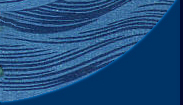
Fireworks
27 June 2009
By Michelle Damian
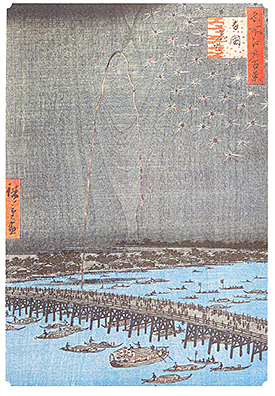
Fireworks by the Ryogokubashi Bridge, by Ando Hiroshige. From Hiroshige: One Hundred Views of Edo, by Mikhail Uspensky (large view)
On the Fourth of July in the United States, most people celebrate by watching fireworks displays. My day was devoted more to the woodblock prints of fireworks at Ryogoku Bridge, and more importantly, to the boats used for viewing them. The past several weeks I have been writing in-depth about the various construction details on each of the watercraft, from the different types of transoms and propulsion, deck and hull planking patterns, fasteners, rigging, stemposts, and anything else I can think of. It has been a challenge to describe each feature in enough depth to address questions of ship construction, yet for now to try to confine myself mostly to the information that can be gleaned from the prints. I could easily write volumes on one type of ship alone; trying to cover pleasure, fishing, cargo, and ferry boats (and still finish my MA thesis before I have to write my dissertation!) is formidable.
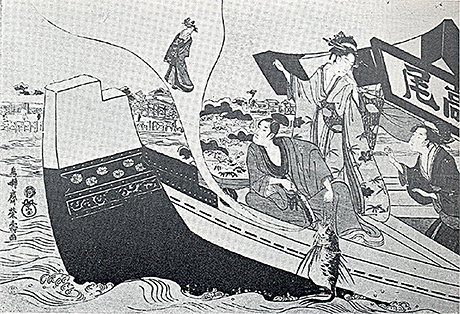
Notched stempost of a yakatabune. Takao, by Eiju. From A Treasury of Japanese Wood Block Prints Ukiyo-e, British Museum Publications (large view)
But back to the fireworks. One type of vessel that has intrigued me is the massive yakatabune, boats used for pleasure gatherings on the river. They have a solid superstructure with heavy supporting posts and cross timbers, usually decorated with lanterns bearing the names of the restaurants that had dispatched them, and are often shown with smaller craft alongside used to ferry patrons or cook the food. While not limited to fireworks scenes, prints of the summer fireworks at Ryogoku Bridge on the Sumida River invariably show one or more of these vessels. They have, however, stumped me. Looking closely at the stemposts reveals much more decoration than stemposts on most other vessels. This in and of itself is not unusual for pleasure boats. Aesthetics as well as advertising on pleasure vessels resulted in more elaborate decorations, sometimes including the relevant family crests. What is unusual, though, is the notch at the tip of the stempost. These vessels almost always have an extra protrusion at the end.
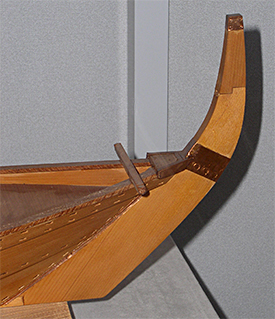
Stempost on a yakatabune model from the Fune no Kagakukan. Note the different colors on the scarfed stempost. (large view)
If the mystery ended there I could chalk it up to simply the convention for the yakatabune – perhaps just aesthetic, perhaps for whatever reason just an additional visual cue to the boat’s purpose. On a model of a similar ship in Tokyo’s maritime museum (Fune no Kagakukan), though, the stempost is apparently made of two separate pieces of wood scarfed together with a notch exactly like the tip of the stemposts in the prints. It is as though the boats shown in the prints had removed that extra piece of wood, leaving the uneven notch exposed. The model is based on the renditions of yakatabune in the Funakagami (Ship’s Mirror), an Edo-period scroll listing the vessels that plied the Edo area rivers. When I asked the curator at the museum about it, he did not know why the stempost seemed to be a composite structure, nor why the yakatabune in the prints would have the notch exposed. If anyone has any thoughts or suggestions to help solve this mystery, I would be most grateful to hear them!
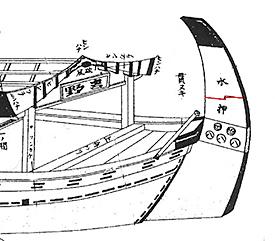
Funakagami sketch of the yakatabune stempost. Note the notch highlighted in red. From Kinsei Nihon no Kawabune Kenkyu, by Kawana Noboru.
Fortunately this is probably my biggest (though not only) remaining question mark when dealing with construction details. The combination of the prints, ethnographic research, and the Japanese resources I have found discussing ship construction have been incredibly helpful at piecing together how the boats were made. One particularly tricky part with the prints has been occasionally trying to fit square pegs into a round hole. I have all of these wonderful resources that allow me to name the vessel types: I know, for example, how I should be able to differentiate the two different types of fishing boats called oshiokuribune or karibune, which can look similar at a quick glance. I may know this…. But the artists perhaps did not. I find myself looking at the same print again and again, asking myself if it is supposed to be type A or type B. Planking patterns can be slightly off, the stempost might protrude just a little too much… My inclination is to try to assign a value to every single vessel in every print, but stylization, abbreviation, and just plain lack of detail make that impossible. It is an education in ways in which the prints can be valuable sources of detail, and in ways in which they fall short.
Two steps forward, a half step back… each bit of research and progress leads to more questions, and I suppose that is how it should be.
As always please feel free to contact me at muaprojectjournal@yahoo.com with any comments, questions, or suggestions during the weeks to come. Yoroshiku onegai shimasu ("I look forward to your good favor").
Return to Project Journal home page.

